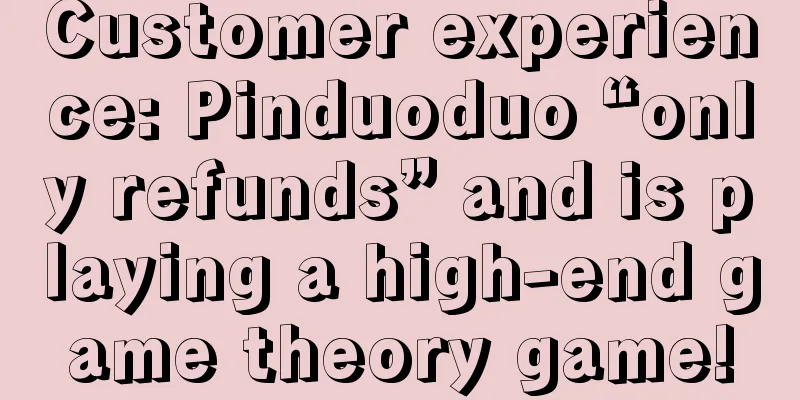6000 words of marketing truth: 7 brand and marketing suggestions for managers!

Why is brand positioning a million-dollar event? What is the difference between pseudo-positioning and true positioning? How to do brand positioning well? Next, as the title says, without further ado, let’s get straight to the point! 1. About the brand1. Starting a business is a process of discovering market user needs and solving themMany people think that starting a business is just about having an idea, raising funds, acquiring users, raising more funds, increasing advertising valuation, and acquiring more users. But I want to pour cold water on this, because this kind of operation is an unhealthy flywheel that only revolves around capital, but not focusing on users and experience. The real purpose of entrepreneurship is to discover "market user needs" and solve the "needs process", but for a need to be met, the following points need to be considered: (1) User It is not the needs you think you have, nor the needs of your relatives and friends, but the needs of the users you are targeting in the future. The main body of the needs is the target users. Suppose there is a boss who thinks he understands user needs very well and requires the product team to implement the product according to his personal wishes and needs. The result is often that the product is a customized version of the boss's own, rather than a product for the general public. This is very scary. (2) Problem Regardless of the size of the problem or the scenario, as long as it is a problem that the user needs to solve, it is a demand. Here we can use "pain points", "itch points" or Maslow's model as a reference, which can help us define the size and severity of the problem. (3) Issues that need to be addressed There are many problems that do not need to be solved, some of which stem from our lack of understanding of users. For example, we believe that all fat people should lose weight, but there are definitely many fat people who think this is not their problem. (4) Users often express demands rather than needs At the same time, market research that does not take user emotions into consideration is meaningless. There is a joke: "Customers want a faster horse, but product designers use a car to make customers more satisfied." Yu Jun, the father of Baidu Tieba, said: "I read every user feedback, but I ignore all user suggestions." It is the same principle. (5) Insight into customers’ ideological needs It is possible to understand the mainstream emotional expressions in the target market, because new emotional needs are often hidden behind consumers' boredom with mainstream expressions. For example, consumers' ideological needs are often hidden in emerging subcultures. They may appear in popular movies and TV series, or in novels, pop music, or even online hot spots. 2. Internet celebrities are a path, not a destinationBecoming an Internet celebrity is the dream of many brands. However, many brands have a misunderstanding and believe that the goal is to make themselves an Internet celebrity. Misunderstanding of this point will cause the influence of internet celebrities to quickly fade away after being popular for a while, because the process of a brand becoming an internet celebrity can be copied, "popular" products can be "referenced" from each other at any time, and an internet celebrity brand may be replaced by a new one at any time. Now let’s take a look at which internet celebrity brands have become outdated and which ones are still strong. Outdated internet celebrity brands: Huang Taiji, Diaoye Beef Brisket, Instant Noodles Canteen, Answer Tea… Strong online celebrity brands: Haidilao, Three Squirrels, Jiangxiaobai, Chayanyuese, Heytea... When you see Haidilao and Three Squirrels, I think you have forgotten that they were once called Internet celebrity brands, but now they have already established their own foothold and no one calls them that anymore. From this point of view, to become an internet celebrity, a brand cannot only have a short-term burst of popularity, but also a long-term plan for popularity so that the brand has sustainable competitiveness. For example, Haidilao, Three Squirrels, Jiang Xiaobai, Chayan Yuese, Heytea, etc., except Jiang Xiaobai, all these popular brands are related to the products/services themselves. That is, the selling points they have formed on the Internet are ultimately empowering product consumption, rather than attracting customers for entertainment experience, for example: (1) In addition to products, we should also pay attention to user experience and repurchase rate Let’s talk about user experience first. How many people go to Haidilao for its delicious food? I believe that few people do so, after all, there are too many hotpot brands that can be replaced in terms of taste. But the reason why Haidilao can become an "Internet celebrity" and "long-lasting" is nothing more than the ultimate user experience under the standardized taste. Secondly, increase repeat purchases. Rather than competing for consumers’ attention, gaining high-frequency repurchases is the battlefield that brands have to challenge. Consumers may buy from you because they want to try something new or curious, but when they decide to repurchase, they will definitely return to rational consumption, and quality, service and other aspects will become the key to decision-making. (2) Continuous innovation to create new value Innovation is not about changing the taste or packaging, which is meaningless. Real innovation is about creating new value, new environment, scenarios and habits. (3) Build brand awareness and establish user emotional connections To build a brand is to build minds, following the trend of consumer minds:
Becoming popular is the starting point of a brand, not its end point. After the craze fades, how to increase product repurchases and user retention, thereby forming a niche market, is the way for Internet celebrity brands to maintain long-term stability. 3. Benefit others first, then yourselfIn 2019, Ma Huateng first defined Tencent's vision as "user-centric, technology for good." He explained, "We believe that technology can benefit mankind." This is the first time that a Chinese technology company has defined its corporate vision as the ultimate pursuit of mankind. Goodness is to help every individual achieve a better self. The fundamental meaning of goodness is to benefit others, and benefiting others is to benefit oneself. This almost perfectly explains the growth path of a large number of Internet products in China today, from the free model to realizing user value and finally realizing their own value. For example: Keep gives users the courage and persistence they need most, making people believe that the more self-disciplined they are, the more free they are. Hema Fresh wants to use technology to bring people a "fresh life". Xianyu aims to solve your idleness and turn your idle time into cash. After observing successful companies for a long time, I think the most worthwhile thing to learn is that they don’t first think about “how to make huge profits from customers”, but work hard to satisfy customers and provide high-value goods or services. Recently, I feel that the company that has implemented this thinking most thoroughly is Pang Donglai. Let’s take a look at the “amazing” devilish operating details of Pang Donglai:
… Good service means always taking one step further for consumers. This altruistic thinking attracts and solves the needs of a large number of users, which is continuous and endless. The starting point of all business is to benefit consumers. "This is an era where perception is more important than telling." No consumer will refuse something that is beneficial to them. When presenting itself to the outside world, the brand embodies the quality of "altruism" from beginning to end, which means it is 99% successful from a genetic point of view, and the remaining 1% is just a matter of "skill". 4. The ultimate goal of an enterprise is to become a customer-oriented enterpriseToday, when we talk about "user experience", "user thinking" and "customer relationship management", they are not new concepts, but inevitable cyclical trends when history advances to "oversupply of ordinary products". We all know that there are many types of maternal and infant products, and the purchasing standards are relatively professional and complicated. Many mothers are buying for the first time, and the consequences of buying the wrong product are very serious. At the same time, there is no perfect offline channel for maternal and infant products, and the cost of acquiring customers is very high. What is suitable for this kind of industry? Let’s look at a case: The King of Children. 95% of the traffic of Kidswant's offline stores comes from members, and the other 5% comes from individual customers. The membership conversion rate of users is as high as 76%, and the member repurchase rate is over 80%. Half of the members can reach an average frequency of 3 purchases in 2 months. Many people are curious: Why can Kidswant's offline stores have such good performance? Why can the member repurchase rate of Kidswant reach over 80%? The reason is inseparable from user thinking. Unlike traditional channel operators, Kidsland gave up simple growth in scale and shifted from operating products to operating customers. It began to pursue single-customer growth - that is, digging deep into a specific group of people, accurately identifying their needs, and satisfying them in all aspects by adding products and services. It has rapidly developed more than 10 million members through a membership model. It has become a comprehensive solution provider for shopping and growth services such as clothing, food, housing, transportation, play, and education for expectant mothers and children aged 0-14. The store also provides various maternal and child services, such as early childhood education, new mother training and other courses and activities in each store. Focusing on the customer management concept, Kidswant G6 Smart Store focuses on four core aspects:
It can be seen that these four cores are exactly the four elements of new retail. Specifically, Kidswant's G6 smart store reduces the space for product display, increases the space for parent-child interaction, and enhances the parent-child entertainment experience; Kidswant also launched 3,000 exclusive and customized products to stabilize customer relationships and improve customer stickiness and loyalty. At the same time, it also uses member data accumulation and data inventory to deeply explore the parenting needs of new families, select brands that users have potential needs or prefer, and realize the transformation of products from broad to precise. Not just Kidswant, I firmly believe that the core logic of future brands will be about operating users rather than operating channels. This means that large companies need to bid farewell to the traditional channel-centric organizational structure and switch to a user-centric organizational structure, while small companies need to expand their user operation system to omni-channel. 2. About Marketing1. Smart brand marketing has never been about selling their products alone, they have always been about selling their valuesLet me ask you two questions first: When you buy accessories, do you limit yourself to a certain brand? Are you restricted to a certain store when drinking beverages or coffee? I believe many people’s answer is yes. Many people explain that it is because a certain brand of coffee tastes good, or a certain brand of jewelry can make you look more elegant. There are many different answers. In fact, this is both right and wrong. In the final analysis, the reason you recognize a brand is that you have feelings for that brand. Where do those feelings come from? They come from the sense of happiness that the brand creates for you. Take Nike for example. Nike sells merchandise, they sell shoes, but when you think of Nike, you think of it as something different than just ordinary shoes. Their ads don't mention their products much, nor do they mention how their air cushion is better than Reebok's. What do Nike's ads say? They praise great competitive sports and athletes. Its brand concept is very clear, which is just do it! It is a kind of competitive spirit of sports, a spirit of perseverance to challenge oneself and never give up, and it makes marketing return to values. Today's market conditions are completely different from those 10 years ago. A brand is no longer a label that needs to be recognized by the public. It is not enough for it to represent good quality, good service, high grade, and being everywhere; it must be a differentiated spiritual and cultural product recognized by a specific user group or community, which involves a recognition of values. Therefore, smart brand marketing has never been about simply selling their products. They have always been selling their values, selling labels, and linking any product with a good lifestyle, thus forming a concept that makes consumers feel as if they can live a beautiful and happy life after purchasing this product. Therefore, what can truly penetrate into the minds of consumers and occupy permanent mental resources is definitely not a product differentiation interest point, but a moving value. Differentiated product interest points will only make people like them temporarily, but will not love them forever. A good brand person must be able to study deep needs, and more importantly, understand the desires of consumers. In previous sharing, I often talked about the point that brand = expectation. Only the psychological satisfaction that exceeds consumers' expectations can be called satisfaction. The same is true for product profit. The part that exceeds the basic interest cognition of the consumer group is the unique value of your product, which is also your profit. In short, the reason why consumers are willing to pay more is not only because of the product and service experience, but more because your product satisfies their desires rather than basic functional needs. Although desire and need seem to be easily confused and the two are often used interchangeably, there is actually an essential difference between the two. To put it bluntly, two people want to eat Snickers at the same time, one wants the sweetness and the other wants to replenish calories. Sweetness is only a superficial need. In our daily life, if we want to tell time, we can spend 199 yuan on Taobao to buy a watch with free shipping and very accurate time, but the sky-high priced Rolex is still popular. In fact, there is no difference between the two in terms of usage functions, but the desires are very different. Therefore, if it only meets needs, there can be no product premium value. When consumers buy simply to satisfy needs, they look for the lowest price; real profits must come from satisfying people's desires, not needs. So, what are the desires of consumers?
Therefore, for marketing implementation, products and services must be transformed from satisfying needs to realizing desires. Brand building must take into account the desire inspiration of subsequent products, return to the human heart and human nature, find out the desires of consumers, and then you will find the entry point for marketing. Taking the intermittent fasting products that were very popular in the past few years as an example, the HeyJuice brand successfully turned the intermittent fasting products into a product with social currency attributes. Imagine that during lunch time in the office, you take out a bottle of fruit and vegetable juice instead of greasy food. The good-looking design and the "detoxification and weight loss" effect promoted by the product make users feel "positive and pursuing quality life" and generate virtual imagination of the brand's communication point of slimming down. Not to mention that when you post these beautiful products on your Moments, you can easily gain likes and comments from a lot of friends, making you feel like “I’m living the life of the top 5%”, thus satisfying your vanity. Therefore, brands need to understand people's hearts and make them feel that they have entered the world they desire. We need to adjust the rules of the game to cater to consumers' needs to show off their status to their friends and build the image they desire. We can summarize that the "relationship between brand and product" reflected in the "integration of brand and effect" is: what we provide to consumers is neither a product that only focuses on functions nor an illusory brand, but a set of "brand solutions". This solution is applied to brand marketing:
3. Brands should not only return to value realization in terms of marketing objectives, but also find a point in marketing direction that can arouse a high degree of social resonance among users.Some time ago, I was successfully recommended to download the search engine app Quark by an advertisement that said "Don't see ads". In terms of content, Quark directly addresses the core pain point of too many search engine advertisements, directly breaking through the window paper of the search industry and leaving the words "don't watch ads", which forms a sharp contrast with conventional offline advertisements. Quark's marketing can be said to have grasped the key point: to give your world a peaceful life. This is the voice of almost everyone. What’s even more outrageous is that while proving that it has no advertisements, Quark also cleverly and cunningly dissed a wave of other brands in its advertisements, and successfully went viral through its marketing operations. Do you know? Do you know? Do you really know? We don't have ads. (Compared to Zhihu website ads) This year, I won’t accept any gifts during the festival and won’t search for any advertisements (compared to Melatonin advertisements) Don’t look at the ads, don’t talk to the boss, just don’t look at them. (Compared to boss recruitment APP) Are you okay? Are you okay? If you are okay, you won’t watch the ads. (Compared to the Lychee Plum snack ads) … Quark's reverse operation not only addressed the users' pain points, but also established an emotional "united front" with users. Quark is simply a newborn calf that is not afraid of a tiger. While causing trouble for its peers with its creativity, it also captured the minds of users. It can be said that it is very tough! This provides us with a good reference. Brands should not only return to value realization in terms of marketing purposes, but also find a point in the marketing direction that can arouse a high degree of social resonance among users . Only in this way can the influence and vitality of the marketing plan be determined. Starting from emotions, we should find values that are in line with social values and accurately get the public's "itch points". Author: Sister Mulan Source public account: Mulanjie (ID: mulanjie-) |
>>: Brand No. 1: Attack, Defense, Defend, Retreat
Recommend
Can I submit my registration information again if it fails? Reasons Analysis
If you want to open a store on Shopee, you need to...
How many products are uploaded to eBay every day? What is the model?
eBay is one of the major e-commerce platforms in E...
How to connect Wish Logistics? How to solve the logistics problem?
With the booming development of the e-commerce ind...
Does Amazon Japan require VAT? What are the consequences of not registering?
More and more merchants are opening stores on the ...
The 10-yuan "magic tool for making photos" is all bought by young girls. The boss said: I'm afraid of running out of stock
The triangle scarf is rapidly becoming a new favor...
With annual sales of 100 million cups and 30 million members, how does Shanghai Auntie achieve "high conversion" in the private domain?
This article starts with Shanghai Auntie, the &quo...
On the release date of Black Myth: Wukong, we recorded 66 numbers related to it
Black Myth: Wukong was officially unlocked yesterd...
How to find the source of goods for cross-border e-commerce? Method introduction
Cross-border e-commerce is becoming more and more ...
Forecast of entertainment live streaming trends in 2025: Breakthrough, cross-border and leading new trends (AI version)
According to the tradition of audio-visual observa...
User operation practice: fresh supermarket user operation case sharing
When user import is abnormal and you can't fin...
Bamboo tube milk tea has exploded again. Can marketing still rely solely on the "Internet celebrity" label?
Pay attention to major social media sites, and you...
Can Xiaohongshu’s buyers’ first 618 shopping event support the platform’s e-commerce ambitions?
Why is this year's 618 promotion difficult but...
When the boss walks into the live broadcast room: the "traffic code" of local life and the road to "brand building"
Driven by the wave of digitalization, the marketin...
Xiaohongshu advertising follow-up and data collection
When operating Xiaohongshu, many bloggers don'...
Is Shopee Philippines easy to operate? How is the e-commerce environment?
As we all know, the first sites that Shopee platfo...









